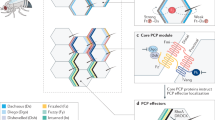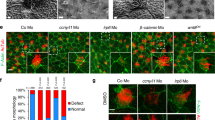Abstract
Cilia are microtubule-based organelles that project into the extracellular space, function in the perception and integration of environmental cues1, and regulate Hedgehog signal transduction2. The emergent association of ciliary defects with diverse and pleiotropic human disorders3,4 has fuelled investigations into the molecular genetic regulation of ciliogenesis. Although recent studies implicate planar cell polarity (PCP) in cilia formation, this conclusion is based on analyses of proteins that are not specific to, or downstream effectors of PCP signal transduction5,6,7,8,9,10. Here we characterize zebrafish embryos devoid of all Vangl2 function11, a core and specific component of the PCP signalling pathway. Using Arl13b–GFP as a live marker of the ciliary axoneme, we demonstrate that Vangl2 is not required for ciliogenesis. Instead, Vangl2 controls the posterior tilting of primary motile cilia lining the neurocoel, Kupffer's vesicle and pronephric duct. Furthermore, we show that Vangl2 is required for asymmetric localization of cilia to the posterior apical membrane of neuroepithelial cells. Our results indicate a broad and essential role for PCP in the asymmetric localization and orientation of motile primary cilia, establishing directional fluid flow implicated in normal embryonic development and disease.
This is a preview of subscription content, access via your institution
Access options
Subscribe to this journal
Receive 12 print issues and online access
$209.00 per year
only $17.42 per issue
Buy this article
- Purchase on Springer Link
- Instant access to full article PDF
Prices may be subject to local taxes which are calculated during checkout





Similar content being viewed by others
References
Singla, V. & Reiter, J. F. The primary cilium as the cell's antenna: signaling at a sensory organelle. Science 313, 629–633 (2006).
Gerdes, J. M., Davis, E. E. & Katsanis, N. The vertebrate primary cilium in development, homeostasis, and disease. Cell 137, 32–45 (2009).
Bisgrove, B. W. & Yost, H. J. The roles of cilia in developmental disorders and disease. Development 133, 4131–4143 (2006).
Quinlan, R. J., Tobin, J. L. & Beales, P. L. Modeling ciliopathies: primary cilia in development and disease. Curr. Top. Dev. Biol. 84, 249–310 (2008).
Park, T. J., Haigo, S. L. & Wallingford, J. B. Ciliogenesis defects in embryos lacking inturned or fuzzy function are associated with failure of planar cell polarity and Hedgehog signaling. Nature Genet. 38, 303–311 (2006).
Park, T. J., Mitchell, B. J., Abitua, P. B., Kintner, C. & Wallingford, J. B. Dishevelled controls apical docking and planar polarization of basal bodies in ciliated epithelial cells. Nature Genet. 40, 871–879 (2008).
Oishi, I., Kawakami, Y., Raya, A., Callol-Massot, C. & Izpisua Belmonte, J. C. Regulation of primary cilia formation and left-right patterning in zebrafish by a noncanonical Wnt signaling mediator, duboraya. Nature Genet. 38, 1316–1322 (2006).
Gray, R. S. et al. The planar cell polarity effector Fuz is essential for targeted membrane trafficking, ciliogenesis and mouse embryonic development. Nature Cell Biol. 11, 1225–1232 (2009).
Heydeck, W., Zeng, H. & Liu, A. Planar cell polarity effector gene Fuzzy regulates cilia formation and Hedgehog signal transduction in mouse. Dev. Dyn. 238, 3035–3042 (2009).
Angers, S. & Moon, R. T. Proximal events in Wnt signal transduction. Nature Rev. Mol. Cell Biol. 10, 468–477 (2009).
Ciruna, B., Jenny, A., Lee, D., Mlodzik, M. & Schier, A. F. Planar cell polarity signalling couples cell division and morphogenesis during neurulation. Nature 439, 220–224 (2006).
Zallen, J. A. Planar polarity and tissue morphogenesis. Cell 129, 1051–1063 (2007).
Seifert, J. R. & Mlodzik, M. Frizzled/PCP signalling: a conserved mechanism regulating cell polarity and directed motility. Nature Rev. Genet. 8, 126–138 (2007).
Simons, M. & Mlodzik, M. Planar cell polarity signaling: from fly development to human disease. Annu. Rev. Genet. 42, 517–540 (2008).
Keller, R. Shaping the vertebrate body plan by polarized embryonic cell movements. Science 298, 1950–1954 (2002).
Wallingford, J. B., Fraser, S. E. & Harland, R. M. Convergent extension: the molecular control of polarized cell movement during embryonic development. Dev. Cell 2, 695–706 (2002).
Yin, C., Ciruna, B. & Solnica-Krezel, L. Convergence and extension movements during vertebrate gastrulation Curr. Top. Dev. Biol. 89, 163–192 (2009).
Rida, P. C. & Chen, P. Line up and listen: Planar cell polarity regulation in the mammalian inner ear. Semin. Cell Dev. Biol. (2009).
Ciruna, B. et al. Production of maternal-zygotic mutant zebrafish by germ-line replacement. Proc. Natl Acad. Sci. USA 99, 14919–14924 (2002).
Hirokawa, N., Tanaka, Y., Okada, Y. & Takeda, S. Nodal flow and the generation of left-right asymmetry. Cell 125, 33–45 (2006).
Bisgrove, B. W., Essner, J. J. & Yost, H. J. Multiple pathways in the midline regulate concordant brain, heart and gut left-right asymmetry. Development 127, 3567–3579 (2000).
Serluca, F. C. et al. Mutations in zebrafish leucine-rich repeat-containing six-like affect cilia motility and result in pronephric cysts, but have variable effects on left-right patterning. Development 136, 1621–1631 (2009).
Kramer-Zucker, A. G. et al. Cilia-driven fluid flow in the zebrafish pronephros, brain and Kupffer's vesicle is required for normal organogenesis. Development 132, 1907–1921 (2005).
Okada, Y., Takeda, S., Tanaka, Y., Belmonte, J. C. & Hirokawa, N. Mechanism of nodal flow: a conserved symmetry breaking event in left-right axis determination. Cell 121, 633–644 (2005).
Okabe, N., Xu, B. & Burdine, R. D. Fluid dynamics in zebrafish Kupffer's vesicle. Dev. Dyn. 237, 3602–3612 (2008).
Caspary, T., Larkins, C. E. & Anderson, K. V. The graded response to Sonic Hedgehog depends on cilia architecture. Dev. Cell 12, 767–778 (2007).
Sun, Z. et al. A genetic screen in zebrafish identifies cilia genes as a principal cause of cystic kidney. Development 131, 4085–4093 (2004).
Piel, M., Meyer, P., Khodjakov, A., Rieder, C. L. & Bornens, M. The respective contributions of the mother and daughter centrioles to centrosome activity and behavior in vertebrate cells. J. Cell Biol. 149, 317–330 (2000).
Yin, C., Kiskowski, M., Pouille, P. A., Farge, E. & Solnica-Krezel, L. Cooperation of polarized cell intercalations drives convergence and extension of presomitic mesoderm during zebrafish gastrulation. J. Cell Biol. 180, 221–232 (2008).
Geldmacher-Voss, B., Reugels, A. M., Pauls, S. & Campos-Ortega, J. A. A 90-degree rotation of the mitotic spindle changes the orientation of mitoses of zebrafish neuroepithelial cells. Development 130, 3767–3780 (2003).
Hong, E. & Brewster, R. N-cadherin is required for the polarized cell behaviors that drive neurulation in the zebrafish. Development 133, 3895–3905 (2006).
Jessen, J. R. & Solnica-Krezel, L. Identification and developmental expression pattern of van gogh-like 1, a second zebrafish strabismus homologue. Gene Expr. Patterns 4, 339–344 (2004).
Mitchell, B. et al. The PCP pathway instructs the planar orientation of ciliated cells in the Xenopus larval skin. Curr. Biol. 19, 924–929 (2009).
Gillingham, A. K. & Munro, S. The small G proteins of the Arf family and their regulators. Annu. Rev. Cell Dev. Biol. 23, 579–611 (2007).
Topczewski, J. et al. The zebrafish glypican knypek controls cell polarity during gastrulation movements of convergent extension. Dev. Cell 1, 251–264 (2001).
Jessen, J. R. et al. Zebrafish trilobite identifies new roles for Strabismus in gastrulation and neuronal movements. Nature Cell Biol. 4, 610–615 (2002).
Suster, M. L., Kikuta, H., Urasaki, A., Asakawa, K. & Kawakami, K. Transgenesis in zebrafish with the tol2 transposon system. Methods Mol. Biol. 561, 41–63 (2009).
Kwan, K. M. et al. The Tol2kit: a multisite gateway-based construction kit for Tol2 transposon transgenesis constructs. Dev. Dyn. 236, 3088–3099 (2007).
Villefranc, J. A., Amigo, J. & Lawson, N. D. Gateway compatible vectors for analysis of gene function in the zebrafish. Dev. Dyn. 236, 3077–3087 (2007).
Megason, S. G. & Fraser, S. E. Digitizing life at the level of the cell: high-performance laser-scanning microscopy and image analysis for in toto imaging of development. Mech. Dev. 120, 1407–1420 (2003).
Acknowledgements
We thank Tamara Caspary for her gift of the mArl13b cDNA clone; Adrian Salic and Lila Solnica-Krezel for providing the Centrin–GFP expression construct; Sasha Fernando and Angela Morley for zebrafish husbandry; and Danielle Gelinas for expert technical support. This research was undertaken, in part, thanks to funding from the Terry Fox Foundation, the Natural Sciences and Engineering Research Council of Canada, and the Canada Research Chairs program.
Author information
Authors and Affiliations
Contributions
S.S. generated MZkny mutants; S.S. and B.C. characterized KV cilia orientation; D.V. and S.S. quantified left–right patterning defects; A.B. and D.V. characterized Arl13b localization in wild-type and MZvangl2 mutants. A.B. performed all further experimentation and analysis; B.C. supervised the project and wrote the manuscript.
Corresponding author
Ethics declarations
Competing interests
The authors declare no competing financial interests.
Supplementary information
Supplementary Information
Supplementary Information (PDF 934 kb)
Supplementary Information
Supplementary Movie 1 (MOV 3243 kb)
Supplementary Information
Supplementary Movie 2 (MOV 3195 kb)
Supplementary Information
Supplementary Movie 3 (MOV 2184 kb)
Supplementary Information
Supplementary Movie 4 (MOV 358 kb)
Rights and permissions
About this article
Cite this article
Borovina, A., Superina, S., Voskas, D. et al. Vangl2 directs the posterior tilting and asymmetric localization of motile primary cilia. Nat Cell Biol 12, 407–412 (2010). https://doi.org/10.1038/ncb2042
Received:
Accepted:
Published:
Issue Date:
DOI: https://doi.org/10.1038/ncb2042
This article is cited by
-
A novel role for the chloride intracellular channel protein Clic5 in ciliary function
Scientific Reports (2023)
-
Live imaging and conditional disruption of native PCP activity using endogenously tagged zebrafish sfGFP-Vangl2
Nature Communications (2022)
-
Zebrafish: an important model for understanding scoliosis
Cellular and Molecular Life Sciences (2022)
-
Vangl2 participates in the primary ciliary assembly under low fluid shear stress in hUVECs
Cell and Tissue Research (2022)
-
Planar cell polarity pathway in kidney development, function and disease
Nature Reviews Nephrology (2021)



